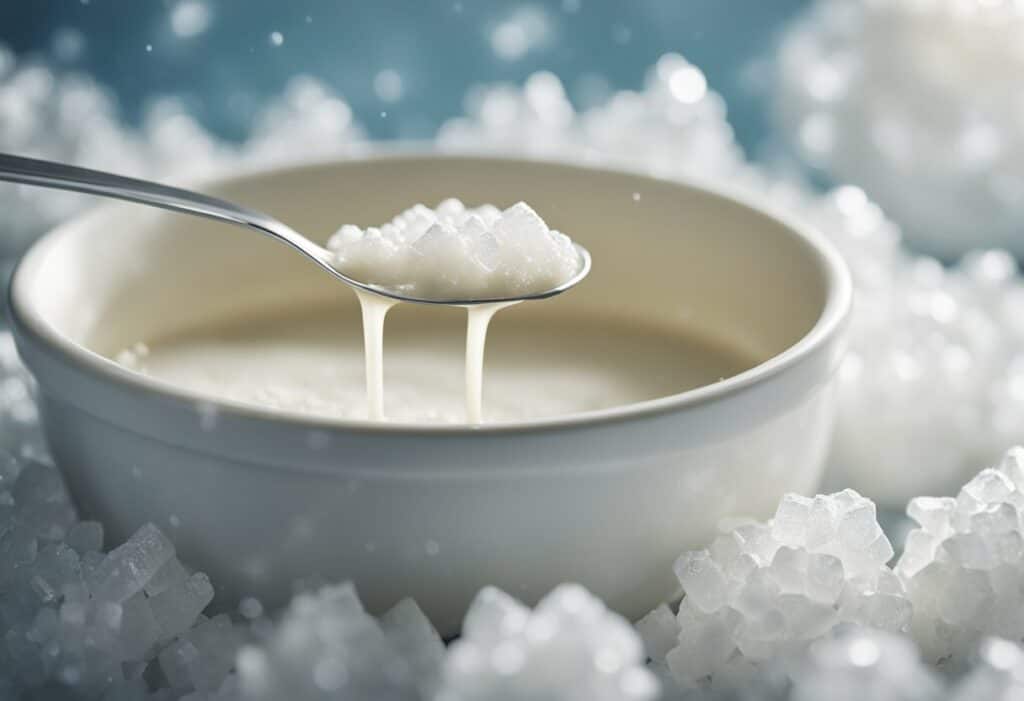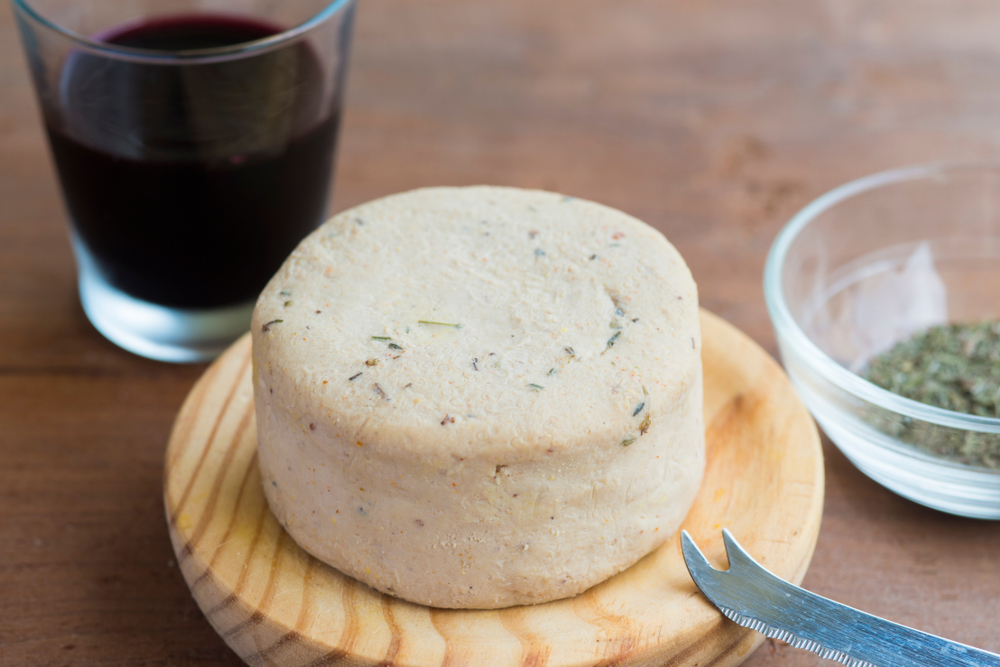I have been asked many times if soy milk can be frozen. The answer is yes, but it requires some preparation and understanding of the process.
Freezing soy milk can extend its shelf life and provide an alternative to throwing it away. Soy milk is a popular non-dairy milk alternative made from soybeans, water, and other additives.
It is a nutritious and versatile milk alternative for those who are lactose intolerant or vegan.

Freezing soy milk can help prevent waste and save money. However, it is essential to know how to freeze soy milk properly to avoid any negative effects on its texture, taste, and nutritional value.
In this article, I will explain the process of freezing soy milk, how to thaw it, and how to use it in recipes. I will also discuss the effects of freezing on soy milk and the nutritional impact of freezing soy milk.
Key Takeaways
- Soy milk can be frozen, but it requires proper preparation and understanding of the process.
- Freezing soy milk can help prevent waste and save money.
- When freezing soy milk, it is essential to know how to freeze it properly to avoid any negative effects on its texture, taste, and nutritional value.
Understanding Soy Milk
As a vegan or someone who prefers plant-based milk, soy milk is a popular choice. It is made by soaking, grinding, and boiling soybeans, then filtering out the solids to create a creamy, smooth liquid.
Soy milk is available in various brands, including Alpro and Silk, but it can also be made at home.
One of the benefits of soy milk is that it is a good source of protein, vitamins, and minerals. It is also naturally cholesterol-free and low in saturated fat, making it a healthy alternative to dairy milk.
Soy milk is also rich in calcium, which is essential for strong bones and teeth. It contains potassium, which helps regulate blood pressure and supports heart health.
When it comes to non-dairy milk, soy milk is one of the most versatile options. It can be used in a variety of recipes, including smoothies, baked goods, and sauces.
It has a creamy texture that makes it an excellent substitute for dairy milk in coffee and tea.
Other types of plant-based milk include oat milk, coconut milk, and almond milk. Each type of milk has its own unique flavor and nutritional profile.
However, soy milk stands out as a popular choice due to its high protein content and versatility in cooking.
In conclusion, soy milk is a nutritious and delicious alternative to dairy milk. It is a good source of protein, vitamins, and minerals, making it a healthy choice for those who follow a vegan or plant-based diet.
Its versatility in cooking and creamy texture make it an excellent substitute for dairy milk in a variety of recipes.
Why Freeze Soy Milk
As someone who enjoys soy milk, I have often wondered whether it’s possible to freeze it for later use. After conducting some research, I have found that it is indeed possible to freeze soy milk.
One of the main reasons to freeze soy milk is to extend its shelf life. Soy milk has a relatively short shelf life, and once opened, it needs to be consumed within a few days.
Freezing soy milk allows you to store it for a longer period, up to three months according to some sources.
Another reason to freeze soy milk is to reduce waste. If you find that you have more soy milk than you can consume before it expires, freezing it is a great way to avoid throwing it away.
It is important to note that freezing soy milk can change its texture and appearance. Upon thawing, the milk may not resemble its original state, and it may be slightly thicker or grainy.
However, this does not affect the taste or nutritional value of the milk.
When freezing soy milk, it’s important to use a freezer-safe container or mason jar. Leave enough empty space at the top because the milk will expand as it freezes since it’s mostly water.
Label the container with the date of freezing to keep track of its shelf life.
Overall, freezing soy milk is a great way to extend its shelf life and reduce waste. While there may be some changes in texture and appearance, the taste and nutritional value remain the same.
Preparation for Freezing

Before freezing soy milk, it is important to prepare it properly to ensure its quality and freshness. Here are some steps to follow:
Choose the Right Container
The container you choose for freezing soy milk is important. It should be airtight and freezer-safe to prevent freezer burn and ice crystals from forming.
You can use a plastic container, a freezer bag, or a mason jar. Make sure to leave some space at the top of the container for the milk to expand as it freezes.
Label and Date
It is essential to label and date the container before freezing. This will help you keep track of the milk’s age and avoid confusion. Use a marker to write the date of freezing and the expiration date on the container.
Portion Size
Freezing soy milk in small portions is a good idea. This will allow you to defrost only the amount you need, reducing waste. You can freeze soy milk in ice cube trays, muffin tins, or small containers.
Store in the Freezer
Once you’ve prepared the soy milk for freezing, place it in the freezer. Make sure to store it in the coldest part of the freezer, such as the back or bottom. This will help the milk freeze faster and stay fresh longer.
Defrosting
When you are ready to use the frozen soy milk, take it out of the freezer and put it in the refrigerator to defrost.
You can also defrost it in the microwave or by placing the container in a bowl of warm water. Make sure to shake or stir the milk well before using it to improve its consistency.
Freezing Process of Soy Milk
I have discovered that freezing soy milk is possible, but it can negatively affect its texture and taste. Freezing soy milk can cause the separation of ingredients, which can alter the flavor and aftertaste of the thawed soy milk.
It is important to store the soy milk properly during the freezing process to prevent other food odors from being absorbed into the frozen soy milk, which can change its taste.
I recommend storing the soy milk in an airtight container or freezer bag to prevent freezer burn and to keep the soy milk fresh.
If you plan to use the soy milk for cooking or baking, freezing it should not be an issue. However, if you plan to drink it as a beverage after freezing, you might notice a difference in its consistency.
To freeze soy milk, you can use an ice cube tray or a freezer-safe container. If using an ice cube tray, pour the soy milk into the tray and freeze until solid.
Once the soy milk cubes are frozen, transfer them to a freezer-safe container or bag.
If using a container, pour the soy milk into the container, leaving some space at the top to allow for expansion during freezing. Seal the container tightly and label it with the date of freezing.
When you are ready to use the frozen soy milk, thaw it in the refrigerator overnight or at room temperature for a few hours.
Once thawed, shake the container or stir the soy milk to combine the ingredients that may have separated during freezing.
Overall, freezing soy milk is possible, but it can affect its texture and taste. Proper storage and thawing techniques can help maintain the quality of the soy milk.
Thawing and Using Frozen Soy Milk
When it comes to thawing frozen soy milk, it’s best to plan ahead. If you know you’ll be using it in a recipe, take it out of the freezer and place it in the fridge to thaw for several hours or overnight.
This will allow the soy milk to thaw slowly and evenly, which will help preserve its texture.
If you need to thaw soy milk quickly, you can place it in a bowl of warm water. Make sure the container is sealed tightly to prevent any water from getting in.
Once the soy milk is thawed, give it a good shake or stir to help recombine any separated ingredients.
It’s important to note that thawed soy milk may have a slightly grainy texture, which can affect the overall quality of certain recipes.
However, if you’re using it in a smoothie or baking recipe, you likely won’t notice the difference.
Once thawed, soy milk should be used immediately or stored in the fridge for up to 5 days. Be sure to give the mixture a good shake or stir before using to help recombine any separated ingredients.
Overall, thawing frozen soy milk is a simple process that just requires a little bit of planning ahead. By following these tips, you can ensure that your thawed soy milk is ready to use whenever you need it.
Effects of Freezing on Soy Milk
As a soy milk lover, I have often wondered if it is possible to freeze soy milk.
After conducting research and examining the effects of freezing on soy milk, I can confidently say that it is possible to freeze soy milk without any major negative effects.
One of the main concerns when freezing soy milk is its texture and consistency. Frozen soy milk may lose its creamy texture and become grainy or light in appearance.
However, this can be easily remedied by stirring the soy milk vigorously after it has thawed. This will help to restore its smooth and creamy texture.
Another concern is the taste of frozen soy milk. Freezing soy milk may slightly alter its taste, but it is not significant enough to make it unpalatable. In fact, some people may not even notice a difference in taste at all.
When it comes to the appearance of frozen soy milk, it may appear slightly different than fresh soy milk. Freezing can cause the soy milk to separate, resulting in a lighter color.
However, this is purely a cosmetic issue and does not affect the nutritional value or taste of the soy milk.
Overall, freezing soy milk is a viable option for those who want to extend the shelf life of their soy milk.
While there may be some minor changes in texture, taste, and appearance, these can be easily remedied by stirring the soy milk after it has thawed.
Using Thawed Soy Milk
Once you have thawed your soy milk, it’s important to know how to use it properly. Here are some tips on how to use thawed soy milk in various recipes:
In Recipes
Thawed soy milk can be used in any recipe that calls for soy milk. It’s important to remember that the texture and taste may be slightly different than fresh soy milk.
However, this difference is usually minimal and won’t affect the overall quality of the recipe.
In Smoothies
Thawed soy milk can be used in smoothies just like fresh soy milk. It’s a great way to add a creamy texture and a boost of protein to your favorite smoothie recipe.
In Cooking and Baking
Thawed soy milk can be used in cooking and baking just like fresh soy milk. It’s a great replacement for dairy milk in recipes for pancakes, muffins, and other baked goods. It can also be used in soups and sauces to add a creamy texture.
In Tea and Coffee
Thawed soy milk can be used in tea and coffee just like fresh soy milk. It’s a great dairy-free substitute for cream or milk and can add a creamy texture to your favorite hot beverage.
In Cereal
Thawed soy milk can be used in cereal just like fresh soy milk. It’s a great way to add a boost of protein to your breakfast.
In Desserts
Thawed soy milk can be used in desserts just like fresh soy milk. It’s a great dairy-free substitute for cream or milk in recipes for ice cream and other desserts.
Reconstituted Soy Milk
If the thawed soy milk has separated or has an unusual texture, it can be reconstituted by shaking or stirring vigorously. This will help to recombine the ingredients and restore the texture of the soy milk.
Overall, thawed soy milk can be used in a variety of recipes and is a great dairy-free substitute for milk or cream. Just remember to store it properly and use it within the recommended time frame.
Safety Considerations

When it comes to freezing soy milk, there are some safety considerations that you should keep in mind. While soy milk can be safely frozen, there are some risks associated with improper storage or thawing.
One of the biggest concerns is the potential for harmful bacteria to grow in the milk. If soy milk is not stored at the proper temperature, it can spoil and become a breeding ground for bacteria.
This can lead to food poisoning and other health concerns.
To avoid these risks, it is important to make sure that soy milk is stored in the refrigerator at a temperature of 40°F or below.
If you are planning to freeze soy milk, make sure that it is properly sealed in an airtight container and placed in the freezer as soon as possible.
It is also important to note that once soy milk has been thawed, it should not be refrozen. This can lead to the growth of harmful bacteria and increase the risk of food poisoning.
If you have leftover thawed soy milk, it should be consumed within a few days to avoid spoilage.
In addition to proper storage and thawing, it is important to be aware of any allergies or sensitivities that you or your family members may have to soy products.
If you or someone in your household has a soy allergy, it is important to avoid consuming soy milk or any other soy products.
Overall, while freezing soy milk can be a convenient way to extend its shelf life, it is important to take the necessary safety precautions to avoid any potential health risks.
By storing and thawing soy milk properly, you can ensure that it remains safe to consume and free from harmful bacteria.
Nutritional Impact of Freezing Soy Milk
As with any food, freezing soy milk can affect its nutritional value. However, the impact is minimal and should not deter you from freezing it for later use.
One of the main concerns with freezing soy milk is the separation of the liquid and solids.
When thawed, the liquid and solids may not mix back together completely, resulting in a slightly altered texture. However, this does not affect the nutritional value of the soy milk.
In terms of fat, freezing soy milk does not affect its fat content. Soy milk is naturally low in fat, making it a great alternative to dairy milk for those looking to reduce their fat intake.
When it comes to nutritional value, freezing soy milk does not significantly impact its vitamin and mineral content.
However, it is important to note that the longer soy milk is stored in the freezer, the more likely it is to lose some of its nutritional value.
In terms of calories, freezing soy milk does not change its caloric content. One cup of unsweetened soy milk contains approximately 80-100 calories, depending on the brand.
Soy milk is known for its health benefits, including being a good source of protein, calcium, and vitamin D.
Freezing soy milk does not affect these health benefits, making it a great option for those looking to incorporate more plant-based foods into their diet.
Overall, freezing soy milk is a great way to extend its shelf life and reduce waste. While it may alter the texture slightly, it does not significantly impact its nutritional value or health benefits.
Comparing Soy Milk with Other Milks

As a non-dairy milk, soy milk is often compared to other types of milk, including dairy milk, coconut milk, almond milk, and oat milk.
Each type of milk has its own unique nutritional profile and taste, making it important to understand the differences between them.
Dairy Milk
Dairy milk is the most common type of milk and is produced by cows. It is a good source of calcium, vitamin D, and protein.
However, it is also high in saturated fat and cholesterol, making it a less healthy option for some people.
Coconut Milk
Coconut milk is a popular non-dairy milk that is made from the flesh of mature coconuts. It has a creamy texture and a sweet, nutty flavor.
Coconut milk is high in saturated fat, but it is also rich in medium-chain triglycerides (MCTs), which may have health benefits.
Almond Milk
Almond milk is made from ground almonds and water. It has a nutty flavor and a creamy texture. Almond milk is low in calories and fat, but it is also low in protein and calcium.
Oat Milk
Oat milk is made from oats and water. It has a mild, slightly sweet flavor and a creamy texture. Oat milk is a good source of fiber and is often fortified with calcium and vitamin D.
Non-Dairy Milk
Non-dairy milk refers to any type of milk that is not produced by a mammal. This includes soy milk, almond milk, and oat milk, among others. Non-dairy milk is often preferred by vegans and people with lactose intolerance.
Vegans
Vegans are people who avoid all animal products, including milk and dairy products. Soy milk is a popular choice for vegans because it is a good source of protein and other nutrients that are important for a healthy diet.
Frequently Asked Questions
Can you freeze soy milk in a carton?
Yes, you can freeze soy milk in a carton. However, it is important to note that the carton may expand as the liquid freezes, so make sure to leave some room at the top of the container.
It is also recommended to shake or stir the soy milk after thawing to improve its consistency.
How long does frozen soy milk last after thawed?
Frozen soy milk can last up to 3 months in the freezer. Once thawed, it can last up to 7 days in the refrigerator.
It is important to consume the soy milk within this time frame to ensure the best quality and taste.
Can you freeze lactose-free soy milk?
Yes, you can freeze lactose-free soy milk just like regular soy milk. The freezing process does not affect the nutritional value of the milk.
However, it is important to note that the texture and taste may change slightly after thawing.
Does freezing soy milk change the taste?
Freezing soy milk may slightly change its taste and texture. Some people may not notice a difference, while others may find the taste to be slightly different after thawing.
It is recommended to shake or stir the soy milk after thawing to improve its consistency.
How do you properly store soy milk after opening?
After opening, soy milk should be stored in the refrigerator and consumed within 7-10 days. It is important to keep the container tightly sealed to prevent any bacteria growth or contamination.
Can you freeze soy milk in plastic bottles?
Yes, you can freeze soy milk in plastic bottles. However, it is important to note that the plastic may expand as the liquid freezes, so make sure to leave some room at the top of the container.
It is also recommended to shake or stir the soy milk after thawing to improve its consistency.







